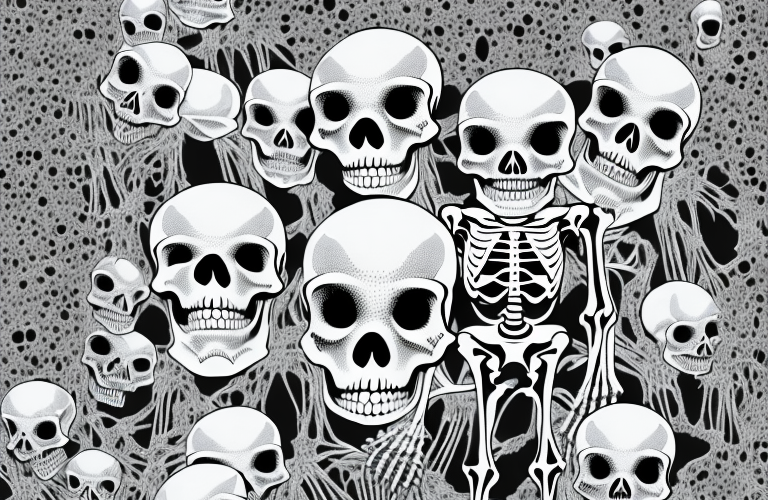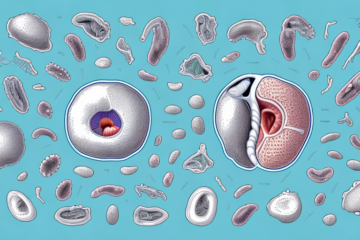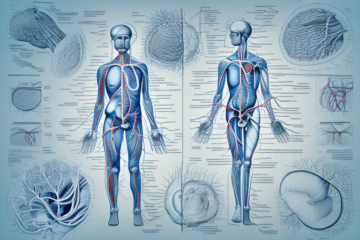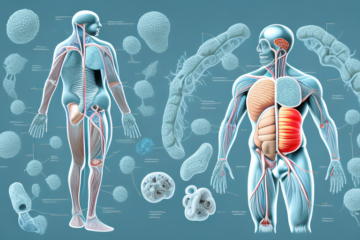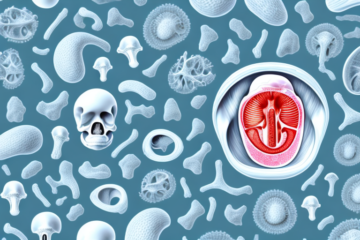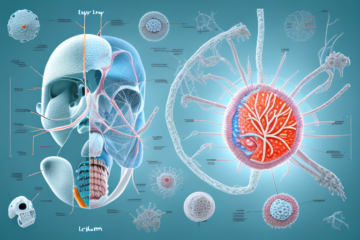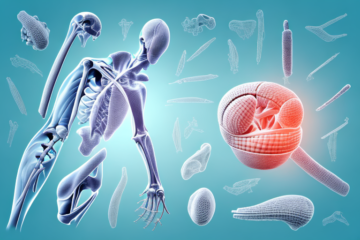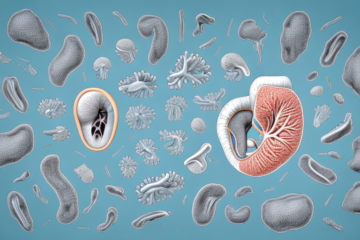Bones are a vital part of the human body, providing support, protection, and structure for our entire system. In this article, we will explore the various functions and anatomy of bones, as well as common health issues related to them and ways to maintain their health and strength.
The Importance of Bones in the Human Body
Without bones, our bodies would not be able to maintain their shape, move, or protect vital organs from injury. Bones provide support for the muscles to work and help us maintain an upright posture. They also create a protective cage for delicate organs such as the brain, heart, and lungs. Additionally, bones are responsible for the production of red and white blood cells in the bone marrow.
Bones are also important for storing minerals such as calcium and phosphorus, which are essential for maintaining strong and healthy bones. When the body needs these minerals, it can draw upon the reserves stored in the bones. This is especially important during times of growth and development, such as childhood and adolescence, as well as during pregnancy and breastfeeding.
The Anatomy of Bones: Structure and Composition
Bones are made up of different components and structures that contribute to their unique properties. The outer layer of bone is called the periosteum, which is a thin membrane containing blood vessels and nerves. Beneath this layer is the cortical or compact bone, which is dense and strong. The interior of the bone is mostly made up of spongy or cancellous bone, which contains marrow and other blood-forming tissues.
In addition to their structural components, bones also play a crucial role in the body’s mineral balance. Calcium and phosphorus are stored in bones, and when the body needs these minerals for other functions, such as muscle contraction or nerve signaling, they are released into the bloodstream. This process is regulated by hormones such as parathyroid hormone and calcitonin.
Bones are also dynamic structures that undergo constant remodeling throughout life. This process is carried out by specialized cells called osteoblasts and osteoclasts, which respectively build and break down bone tissue. This remodeling allows bones to adapt to changes in mechanical stress and maintain their strength and integrity over time.
Types of Bones: Long, Short, Flat, and Irregular
There are four types of bones in our body: long, short, flat, and irregular. Long bones, such as the femur and humerus, are mostly found in the limbs and have a cylindrical shape. Short bones, like those in the wrist and ankle, are cube-shaped and provide stability and some movement. Flat bones, such as the skull and the scapula, protect organs and allow for muscle attachment. Finally, irregular bones, such as the vertebrae, vary in shape and function and have a unique anatomy.
In addition to these four types of bones, there are also sesamoid bones. These are small, round bones that are embedded within tendons and help to reduce friction and increase the efficiency of muscle movement. The patella, or kneecap, is an example of a sesamoid bone.
Bones are not just static structures in our body. They are living tissues that undergo constant remodeling and repair. Osteoblasts are cells that build new bone tissue, while osteoclasts are cells that break down old bone tissue. This process of bone remodeling is essential for maintaining bone strength and density throughout our lives.
The Bone Growth Process: How Bones Develop in Humans
Bones in the human body grow and develop in a specific process. During embryonic development, the skeletal system starts as soft cartilage tissue, which then begins to ossify or turn into bone as the child matures. As we age, bones remodel themselves by breaking down old bone and building new bone tissue. This process is essential to maintain bone density and strength throughout life.
In addition to the natural bone growth process, there are several factors that can affect bone health. These include nutrition, physical activity, and hormonal changes. Adequate intake of calcium, vitamin D, and other nutrients is important for bone development and maintenance. Regular weight-bearing exercise, such as walking or weightlifting, can also help strengthen bones. Hormonal changes, such as those that occur during menopause, can lead to a decrease in bone density and increase the risk of osteoporosis. It is important to take steps to maintain bone health throughout life to prevent fractures and other bone-related issues.
Understanding Bone Density and Mineralization
Bone density refers to the amount of mineralization in our bones, which determines their strength and resilience. As we age, our bones become less dense and fragile, leading to common health issues such as osteoporosis. Calcium, phosphorus, and vitamin D are crucial components for maintaining healthy bone density and mineralization.
Regular exercise, particularly weight-bearing exercises such as walking, running, and weightlifting, can also help maintain healthy bone density and mineralization. Additionally, avoiding smoking and excessive alcohol consumption can also contribute to better bone health. It is important to prioritize bone health throughout our lives to prevent fractures and other complications associated with weakened bones.
The Role of Bones in Movement and Mobility
Bones play a significant role in movement and mobility. Together with the muscles and tendons, bones form the musculoskeletal system, which enables us to move and perform different tasks. The joints between the bones allow for flexibility and movement, while the muscles provide the necessary force to contract and relax, creating motion.
In addition to providing support and facilitating movement, bones also play a crucial role in the production of blood cells. The bone marrow, located inside the bones, is responsible for producing red blood cells, white blood cells, and platelets. These blood cells are essential for carrying oxygen, fighting infections, and clotting blood, respectively. Without healthy bones, the production of these vital blood cells can be compromised, leading to various health issues.
Common Bone-Related Health Issues and Conditions
Some common bone-related health issues and conditions include osteoporosis, fractures, and bone infections. Osteoporosis is a condition in which the bones become weak and brittle, leading to an increased risk of fractures. Fractures can occur due to trauma or underlying bone disease. Bone infections, such as osteomyelitis, can occur due to bacterial or fungal infection and require prompt treatment to avoid complications.
Another common bone-related health issue is osteoarthritis, which is a degenerative joint disease that affects the cartilage in the joints. This can lead to pain, stiffness, and limited mobility. Treatment options include medication, physical therapy, and joint replacement surgery.
Additionally, bone cancer is a rare but serious condition that can affect any bone in the body. Symptoms may include pain, swelling, and fractures. Treatment options depend on the type and stage of the cancer and may include surgery, radiation therapy, and chemotherapy.
Tips for Maintaining Healthy Bones at Any Age
There are several things one can do to maintain healthy bones at any age. Engaging in regular exercise, such as weight-bearing and resistance training, can help build stronger bones. A diet rich in calcium and vitamin D is also essential for maintaining healthy bone density and mineralization. Additionally, avoiding smoking and excessive alcohol consumption can reduce the risk of bone-related health issues.
Another important factor in maintaining healthy bones is getting enough sunlight. Sunlight is a natural source of vitamin D, which is essential for the absorption of calcium in the body. Spending time outdoors, especially during the morning and late afternoon, can help increase vitamin D levels.
It is also important to be aware of any medications that may affect bone health. Some medications, such as corticosteroids and anticonvulsants, can lead to bone loss and increase the risk of fractures. If you are taking any medications, it is important to discuss their potential effects on bone health with your healthcare provider.
How to Prevent Osteoporosis and Other Bone Diseases
Preventing osteoporosis and other bone diseases requires a combination of lifestyle changes and medical interventions. Engaging in regular exercise, following a balanced diet, and avoiding smoking and excessive alcohol consumption can reduce the risk of developing bone-related health issues. On the other hand, medications such as bisphosphonates, hormone therapy, and calcitonin can help increase bone density and prevent bone loss.
Another important factor in preventing bone diseases is getting enough vitamin D and calcium. Vitamin D helps the body absorb calcium, which is essential for building and maintaining strong bones. Foods rich in calcium include dairy products, leafy greens, and fortified cereals. Vitamin D can be obtained through exposure to sunlight or through supplements.
In addition to lifestyle changes and medical interventions, regular bone density screenings are recommended for individuals at risk of developing osteoporosis and other bone diseases. These screenings can detect bone loss early on, allowing for early intervention and treatment to prevent further bone loss and fractures.
Exercise and Nutrition for Stronger Bones
Exercise and nutrition play a crucial role in building and maintaining stronger bones. Weight-bearing exercises, such as running, walking, and dancing, help stimulate bone growth and density. Resistance training, such as weightlifting and calisthenics, can improve muscle mass and bone strength. A diet rich in calcium, vitamin D, and other bone-healthy nutrients, such as magnesium and vitamin K, can help maintain healthy bone density and mineralization.
In addition to exercise and nutrition, there are other factors that can affect bone health. Smoking, excessive alcohol consumption, and certain medications can all contribute to bone loss and weaken bones over time. It’s important to avoid smoking and limit alcohol intake, as well as talk to your doctor about any medications that may affect your bone health. Regular bone density screenings can also help detect any potential issues early on, allowing for prompt treatment and prevention of further bone loss.
Advances in Bone Research and Treatment Options
The field of bone research has advanced significantly over the years, with more effective treatment options available for bone-related health issues. New medications such as denosumab and romosozumab can help prevent bone loss and reduce the risk of fractures. Additionally, advances in bone grafting and bone regeneration techniques have made it possible to repair damaged bones and restore function.
Furthermore, research has shown that exercise and a healthy diet can also play a crucial role in maintaining bone health. Weight-bearing exercises, such as walking and strength training, can help increase bone density and reduce the risk of fractures. Consuming foods rich in calcium, vitamin D, and other nutrients can also help strengthen bones and prevent bone loss.
The Future of Bone Health: Emerging Trends and Technologies
Emerging trends and technologies in bone health are focused on developing more personalized and targeted interventions. Genetic testing and personalized medicine can help identify individuals at high risk of developing bone-related health issues and tailor treatment options accordingly. Additionally, nanotechnology and tissue engineering hold immense promise for developing novel bone grafts and regenerative therapies.
Another emerging trend in bone health is the use of wearable technology to monitor bone health and track progress. Wearable devices such as smartwatches and fitness trackers can measure physical activity, which is a key factor in maintaining bone health. These devices can also track bone density and provide feedback on the effectiveness of interventions such as exercise and medication. With the increasing popularity of wearable technology, it is likely that these devices will become an important tool in the prevention and management of bone-related health issues.
Myth-Busting: Debunking Common Misconceptions About Bones
There are several common misconceptions about bones that need to be debunked. One is that bones are static and unchanging structures. On the contrary, bones are dynamic tissues that respond to mechanical stress and chemical signals, continually remodeling themselves. Another myth is that calcium supplements alone can prevent osteoporosis. While calcium is an essential component of bone health, a balanced diet and regular exercise are also crucial to maintain healthy bones.
In conclusion, bones perform numerous essential functions in the human body, and maintaining their health and strength is crucial for overall well-being. By understanding the anatomy and functions of bones, we can take steps to prevent bone-related health issues and maintain healthy bones at any age.
One more common misconception about bones is that they are lifeless structures. However, bones are living tissues that contain blood vessels, nerves, and bone marrow. Bone marrow is responsible for producing red and white blood cells, which are essential for the body’s immune system and oxygen transport. Additionally, bones play a crucial role in regulating the body’s mineral balance, such as calcium and phosphorus.
Moreover, bones are not just passive structures that provide support and protection to the body. They also act as a reservoir for minerals, such as calcium, that can be released into the bloodstream when needed. This process is essential for maintaining the body’s mineral balance and preventing diseases such as osteoporosis.

